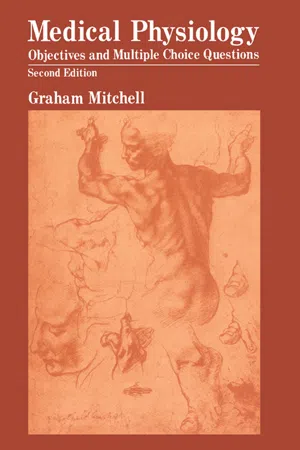
- 166 pages
- English
- ePUB (mobile friendly)
- Available on iOS & Android
About This Book
Medical Physiology: Objectives and Multiple Choice Questions, Second Edition defines explicitly what students should be able to accomplish at the end of a one-year course in human physiology and related biochemistry. The book contains sets of objectives, which outlines the factual knowledge required in a way that should encourage self-study, critical appraisal, and the use of many sources of information. The text presents outlines of topics on basic chemical, physical, biochemical, and physiological concepts. It also provides learning objectives for cell biochemistry, body fluids, connective and support tissue, excitable tissue, nutrition, thermoregulation, and the nervous system. A set of multiple choice questions is found at the end of each section to test the student's knowledge. Medical students, physiotherapy students, occupational therapy students, nursing students and students in related medical sciences will find the book very useful.
Frequently asked questions
Information
INTRODUCTORY OBJECTIVES
Table of contents
- Cover image
- Title page
- Table of Contents
- Copyright
- PREFACE
- HOW TO USE THIS BOOK
- RECOMMENDED TEXTBOOKS
- Chapter 1: INTRODUCTORY OBJECTIVES
- Chapter 2: CELL BIOCHEMISTRY
- Chapter 3: BODY FLUIDS
- Chapter 4: CONNECTIVE AND SUPPORT TISSUE
- Chapter 5: EXCITABLE TISSUE
- Chapter 6: CARDIOVASCULAR SYSTEM
- Chapter 7: RESPIRATION
- Chapter 8: KIDNEY
- Chapter 9: ACID-BASE BALANCE
- Chapter 10: GASTRO-INTESTINAL TRACT
- Chapter 11: ENDOCRINOLOGY
- Chapter 12: METABOLIC REGULATION
- Chapter 13: NERVOUS SYSTEM
- Chapter 14: THERMOREGULATION
- Chapter 15: NUTRITION
- ANSWERS TO MULTIPLE CHOICE QUESTIONS
- REFERENCE VALUES